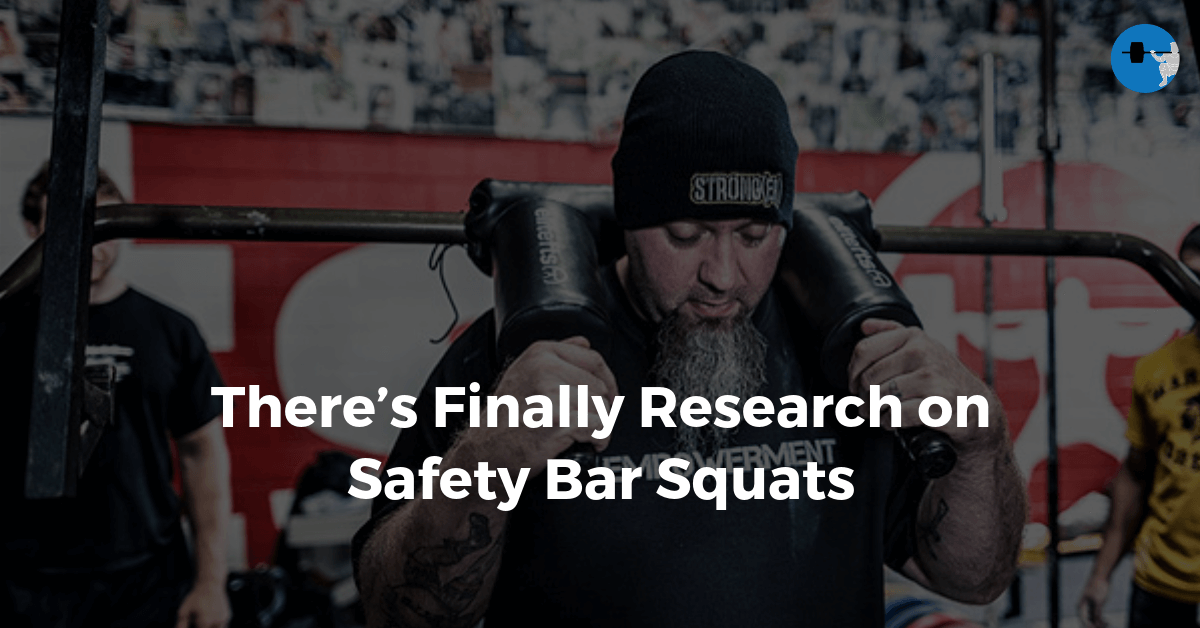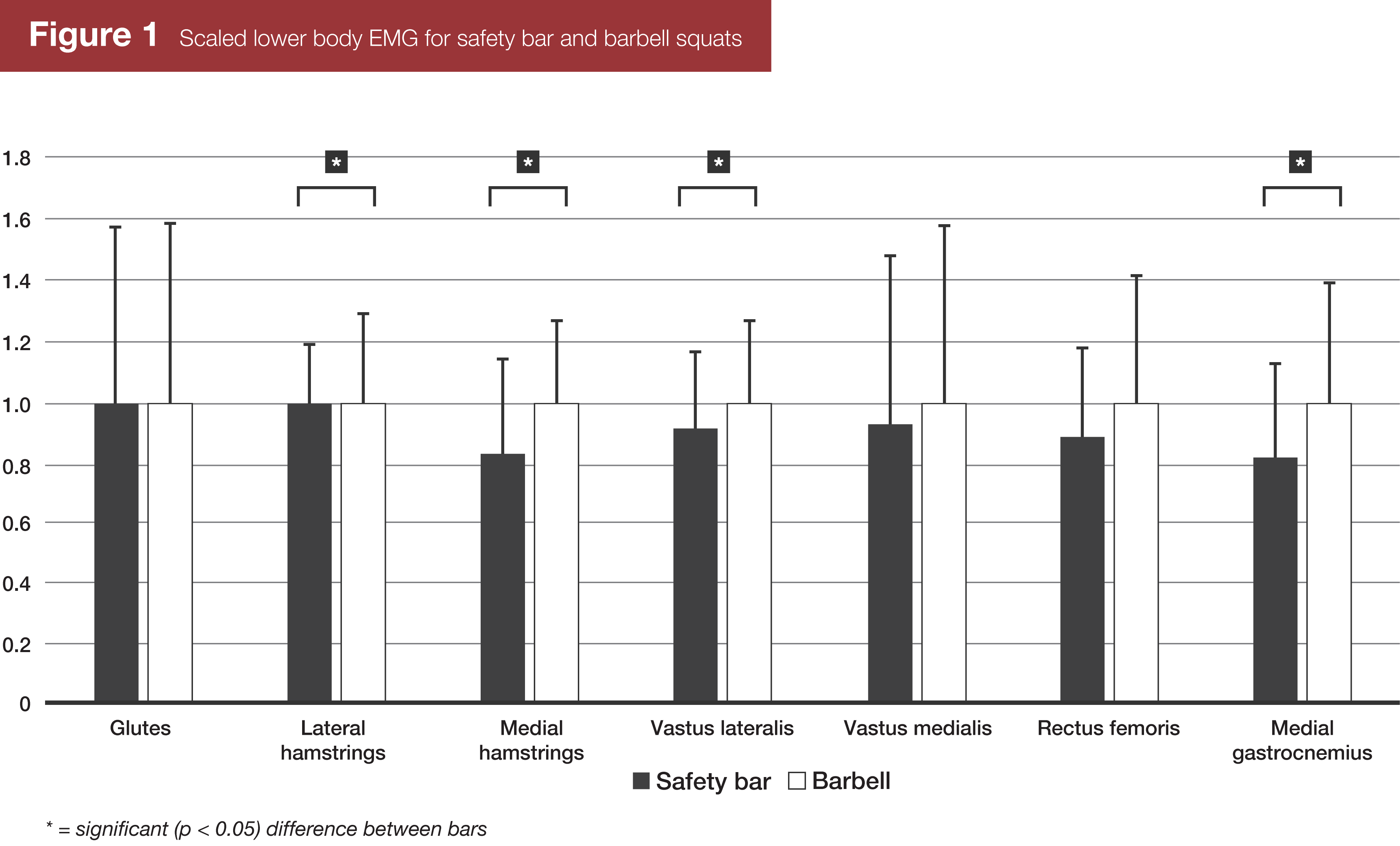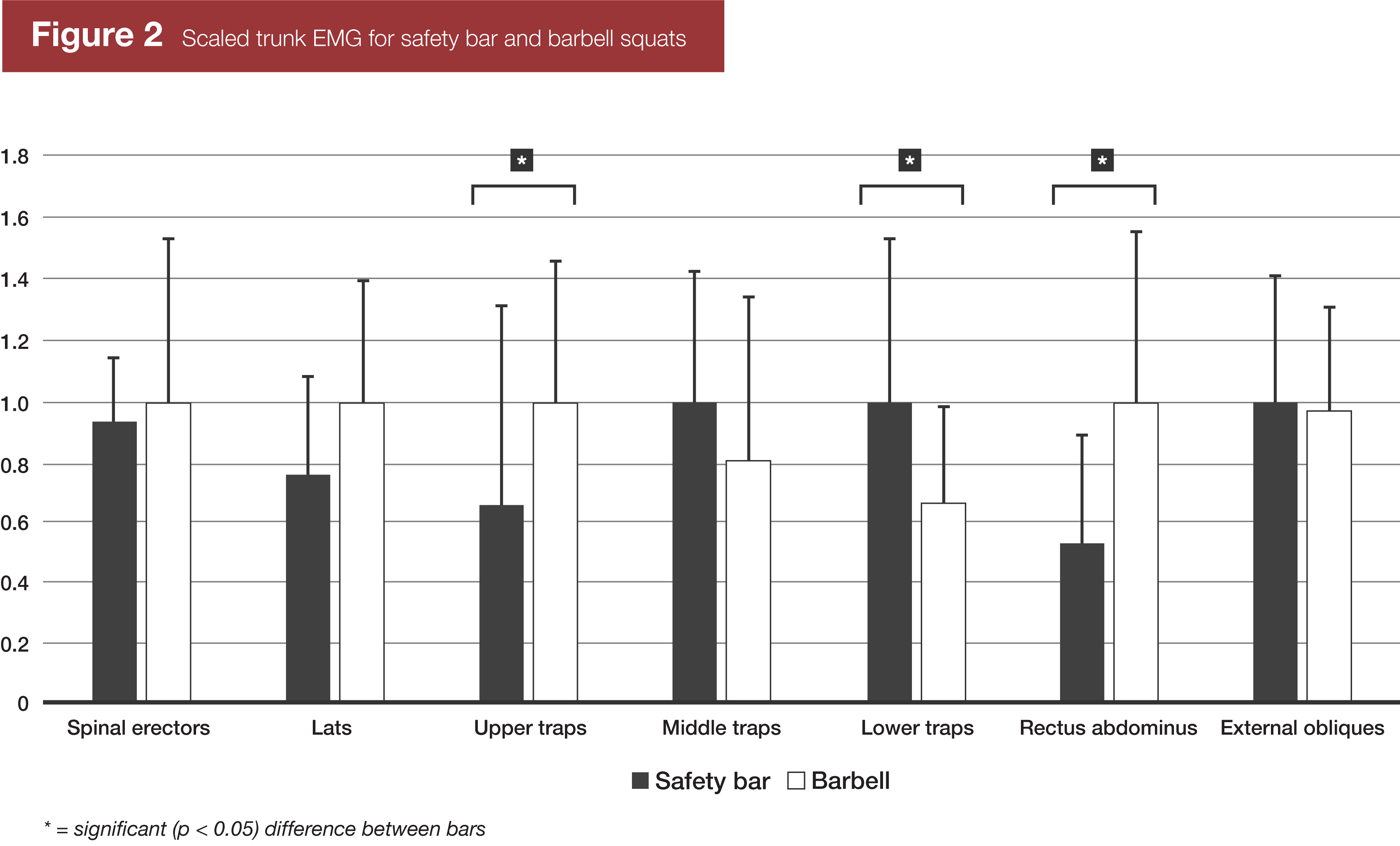This article is a review and breakdown of a recent study. The study reviewed is Effects of the Safety Squat Bar on Trunk and Lower-Body Mechanics During a Back Squat. Hecker et al. (2018)
Key Points
- In this study, competitive powerlifters squatted about 11% less for a 3RM with a safety bar than with a barbell.
- The safety bar led to a more upright torso position and increased lower trap activation (assessed via EMG). It decreased activation in the vastus lateralis, the hamstrings, and the abdominals.
- In spite of the lower EMG readings in this study, a recent longitudinal study found similar adaptations with barbell and safety bar squats. So, if you’re not specifically training for a powerlifting meet, you’re probably not missing out on much if you just use the bar you prefer.
Safety bar squats were first popularized by Fred Hatfield in the ’80s, and they grew in popularity in the late ’90s and early 2000s on the back of Louie Simmons’ endorsement. While they’ve been popular in the gym for over two decades now, safety bars have flown under the scientific radar. They’re so unknown in the scientific literature that the presently reviewed study (1) had to cite a T-Nation article for anecdotal support of the safety bar’s popularity and effects.
However, the safety bar is finally getting some attention. In the present study, researchers had competitive powerlifters test their 3RM squat with a barbell and a safety bar. Then the researchers assessed differences in kinematics (joint ranges of motion and body positioning) and EMG (as a proxy for muscle activation) between the two lifts while the lifters performed reps at 75% of their 3RM. Squatting with the safety bar led to greater lower trap EMG and a more upright torso position, but the barbell squat allowed for a higher 3RM and elicited greater EMG readings in the vastus lateralis, the hamstrings, and the abdominals.
This article is from a previous issue of Monthly Applications in Strength Sport (MASS), my monthly research review with Eric Helms and Mike Zourdos. Each issue of MASS contains at least 9 pieces of content just like this.
Want to get more articles like this? All MASS subscriptions are currently 20% off. The price will go back up in a few days, so act now if you're interested. Click here to learn more and join 2,750+ subscribers.
Purpose and Research Questions
Purpose
The purpose of this study was to compare strength, muscle activation, and joint ranges of motion in the safety bar squat and the barbell back squat.
Hypotheses
The researchers hypothesized that:
- 3RM strength would be lower for the safety bar squat.
- EMG of the upper- and mid-back muscles would be higher in the safety bar squat.
- There would be no differences in lower extremity muscle activation or ranges of motion.
- The safety bar squat would allow for a more upright torso when squatting.
Subjects and Methods
Subjects
The subjects were 12 competitive powerlifters (eight men and four women) who had at least some prior experience with the safety bar squat. Further details about the subjects can be seen in Table 1.
Methods
This study took place over three sessions, with at least one week between sessions. In the first two sessions, subjects worked up to a 3RM on either the barbell back squat or the safety bar squat. In the third session, subjects performed 3 sets of 5 repetitions with 75% of their 3RM using both squat styles. The subjects were allowed to self-select their stance width, but were required to use the same width for both squat styles. All reps had to be performed to legal powerlifting depth. During the safety bar squats, the subjects were told to not press upward on the handles of the safety squat bar. All reps were performed with EMG electrodes on the upper, middle, and lower traps, the spinal erectors, the lats, the rectus abdominis, the obliques, the medial and lateral hamstrings, the vastus lateralis and medialis, the rectus femoris, the medial gastrocnemius, and the glutes. The subjects were also outfitted with reflective markers for kinematic analysis. The authors reported integrated EMG and peak kinematic measurements.
Findings
The subjects squatted 11.3% more with the barbell than the safety squat bar, on average. Rectus abdominis, medial and lateral hamstrings, vastus lateralis, upper trap, and medial gastrocnemius EMG were significantly greater during the barbell squat. On the other hand, lower trap activation was significantly greater during the safety bar squat. Peak hip flexion, ankle dorsiflexion, forward knee travel, and forward lean were significantly greater with the barbell squat. There were no significant differences in glute, vastus medialis, rectus femoris, spinal erector, lat, middle trap, or oblique EMG. There also wasn’t a significant difference in peak knee flexion.
For the graphical representations of the results, I’ve scaled all of the variables based on the higher value in each between-condition comparison so that each graph will be readable. For example, the integrated EMG values for the trunk muscles went as high as 720µV and as low as 44µV, which don’t play well together on the same graph. With scaling, the highest value for each comparison is 1, and the lowest value for any comparison is 0.54.
Interpretation
There were a couple of things that interested me about these results. The fact that the safety bar led to lower rectus abdominis and upper trap EMG readings surprised me; assuming EMG is at all associated with how you feel after training, I would have expected higher abdominal and upper trap EMG with the safety bar. If I’ve only been back squatting for several months, my upper traps and abs are always wrecked the day after a session of safety bar squats.
I was also surprised that EMG for the leg and thigh musculature was so much lower during safety bar squats. At first, this may sound logical: Absolute loading was lower with the safety squat bar, so absolute EMG readings should be lower as well. However, the average loads used were 109.8kg for safety bar squats and 123kg for barbell squats. The average subject weighed 88.1kg, and when you squat, you’re also moving your body mass. Thus, the total load difference was something like 197.8 vs. 211.1 kg (I recognize I’d need to make some adjustments for segmental masses to be completely accurate, but you get the point). This means that the difference in total load was only about 6.3%, not 11.3%. However, the mean EMG differences for the hamstrings and the vastus lateralis were 10.2-20.6%, which are larger than would be expected based solely on differences in loading. We also have a couple of studies comparing back squats and front squats, finding that the lower body EMG differences between back and front squats (which also have clear differences in external loading) are either small (2) or nonexistent (3, 4). So, I wonder if the EMG differences in this study may be partially attributable to differences in comfort and technical proficiency with the two bars. As you learn a new exercise, EMG tends to increase as muscle coordination improves and inhibitory feedback decreases (see Mike’s article on that subject in this month’s issue), and the difference in 3RMs suggests to me that at least some of the subjects weren’t incredibly experienced with safety bar squats. I would have expected a difference of ~5%, rather than ~11%, if the lifters were truly proficient with safety bar squats. The authors also report a range of 2.4-18.9% differences in safety bar and barbell 3RMs. I feel confident saying that people who are truly proficient with a safety bar don’t squat almost 20% less with a safety bar than a barbell. The researchers only excluded people based on having no experience with safety bar squats, so I think it’s plausible that some of the EMG findings could be attributable to differences in experience and proficiency with the two bars. The fact that the safety bar also led to lower abdominal EMG also suggests to me that the lifters may have been bracing less effectively during the safety bar squats, which would support the idea that at least some of the subjects just weren’t very experienced with safety bar squats.
With any acute study, a reasonable follow-up question is “does any of this actually matter for long-term training adaptations?” The authors of this study suggest that, due to the decreased EMG of the quads, hamstrings, and abdominals, “squats with the safety squat bar may be less effective than squats with a standard barbell for increasing lower-extremity strength.” However, I’m inclined to disagree. A study from Meldrum and DeBeliso published a few months ago examines training adaptations after nine weeks of squatting with a barbell or safety squat bar (5). The study was performed on baseball players, and it examined changes in squat strength (the safety bar group only tested strength with the safety bar pre- and post-, and the barbell group only tested strength with the barbell pre- and post-), vertical jump, and 60-yard sprint. I didn’t review this study for MASS because group allocation wasn’t random, so it can’t be used to draw causal inferences (the pitchers squatted with a safety squat bar, and the non-pitchers used a barbell), but the study was otherwise well-done, and the two groups didn’t differ in any major way pre-training. Both groups increased vertical jump height to a similar degree (+1.9cm for the barbell group, and +2.9cm for the safety bar group), both groups had small, non-significant decreases in 60-yard sprint times (-0.07 seconds for the barbell group, -0.08 seconds for the safety bar group), and both groups had large increases in squat strength with the bar they used for training (+29.9kg for the barbell group, +40.3kg for the safety bar group). In fact, strength increased significantly more in the safety bar group, but they were also a bit weaker to start with, so that’s probably not worth getting hung up on (and a great proportion of their strength gains may have been due to learning effects, if the other group was more experienced with barbell squats than they were with safety bar squats).
This makes me more confident that long-term adaptations probably don’t differ very much between barbell and safety bar squats, in spite of the acute EMG differences observed in the present study. In defense of Hecker et al (1), I’m almost positive that this longitudinal study by Meldrum and DeBeliso was published after they’d already submitted the present study for publication.
One set of findings that needs further explanation is that there was virtually no difference between groups in forward knee travel (shank angle and peak dorsiflexion were significantly different between groups, but they only differed by 0.9-1.3 degrees), and peak knee flexion was the same, but peak hip flexion and forward lean were lower with the safety bar. If you’ve got a decent innate grasp of geometry, you’d realize that this set of findings would be virtually impossible with barbell squats, assuming bar position didn’t change. Being significantly more upright with the same amount of dorsiflexion and knee flexion would shift your center of mass backward, beyond your base of support. However, a safety bar shifts the system’s center of mass forward, all else being equal, allowing a more upright posture without also requiring more forward knee travel.
One argument put forth by the authors of this study was that, since safety bar squats allow you to maintain a more upright posture, they’re potentially safer for the lower back. However, I’m skeptical of that argument. If the position of the barbell’s center of mass is unchanged, then yes, a more upright squat may place less stress on your lower back. However, since the safety squat bar shifts the bar’s center of mass forward, I think forces on the spine would be quite similar to those during a barbell squat. In other words, if you weren’t more upright, the safety squat bar would potentially lead to larger forces on the spine. Furthermore, a hefty portion of the force your spine “feels” during exercise isn’t directly attributable to external loading. Rather, it’s a result of the contraction of the muscles surrounding the spine. In this study, spinal erector EMG was the same for both squat styles, which suggests that forces on the spine are similar. Now, it’s possible that safety bar squats may be safer if they lead to less lumbar flexion (which is entirely possible, since they require less hip flexion, on average), but that wasn’t assessed in this study. I’ve heard anecdotal reports that safety bar squats feel better for some people with back issues, and I’ve also heard anecdotal reports that they bother some people more than barbell squats. I think it’s plausible that safety bar squats alter the mechanics of the movement enough that they affect the spine differently (sometimes for the better, sometimes for the worse) for some people, but my assumption is that they’re not inherently better for spinal health.
Ultimately, I think the main benefit of safety bar squats is that they can allow people with upper body injuries or mobility restrictions to squat without issue. A secondary benefit is that they may do a better job building upper back strength than barbell squats. I don’t think they’re necessarily better or worse than barbell squats, and in fact, I think both styles are similar enough to be interchangeable in most contexts. If you’re a powerlifter, you’ll obviously benefit from doing at least some of your training with a barbell so you’re prepared for the platform, but for simply developing lower body strength, I doubt there’s much of a difference between barbell squats and safety bar squats. Feel free to use whichever bar is most comfortable for you.
Next Steps
I’d like to see a longitudinal study similar to the one performed on baseball players, with the addition of random group allocation. Ideally, it would also assess hypertrophy. I’d also be interested in research into the effects of safety bar versus barbell squats on long-term bench press strength gains. Since safety bar squats should lead to less wrist, elbow, and shoulder stress (especially compared to low-bar squats), they may indirectly aid upper body training. I’d also be interested to see research on other specialty bars.
Application and Takeaways
If you’re a powerlifter, you obviously need to squat with a barbell often enough to hone your skills with your competition lift. However, safety bar squats seem to be a perfectly fine squat variation for powerlifters and a perfectly fine alternative for anyone else who just prefers squatting with a safety bar.
Want to learn everything you’d ever want to know about squatting? Check out my How to Squat guide.
The latest research – interpreted and delivered every month
If you want to stay up-to-date on the research pertinent to strength and physique athletes and coaches, but you don't have the time to desire to develop the skill set to critically analyze research, you can sign up for Monthly Applications in Strength Sport (MASS), the monthly research review I put out every month, along with Dr. Eric Helms and Dr. Mike Zourdos.
Each issue of MASS contains at least 9 pieces of content like this. Click here to learn more and join 2,750+ subscribers.
All MASS subscriptions are currently 20% off. The price will go back up in a few days, so act now if you're interested.
References
- Hecker KA, Carlson LA, Lawrence MA. Effects of the Safety Squat Bar on Trunk and Lower-Body Mechanics During a Back Squat. J Strength Cond Res. 2018 Oct 22.
- Yavuz HU, Erdağ D, Amca AM, Aritan S. Kinematic and EMG activities during front and back squat variations in maximum loads. J Sports Sci. 2015;33(10):1058-66.
- Gullett JC, Tillman MD, Gutierrez GM, Chow JW. A biomechanical comparison of back and front squats in healthy trained individuals. J Strength Cond Res. 2009 Jan;23(1):284-92.
- Contreras B, Vigotsky AD, Schoenfeld BJ, Beardsley C, Cronin J. A Comparison of Gluteus Maximus, Biceps Femoris, and Vastus Lateralis Electromyography Amplitude in the Parallel, Full, and Front Squat Variations in Resistance-Trained Females. J Appl Biomech. 2016 Feb;32(1):16-22.
- Meldrum R, DeBeliso M. A Comparison of Back Squat & Safety Squat Bar on Measures of Strength, Speed, and Power in NCAA Division I Baseball Players.International Journal of Sport Science. 2018; 8(5): 137-144.









